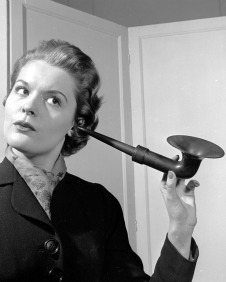You’ve spent hours perfecting your presentation. You have crafted engaging content. You have practiced your delivery.
You will have wasted your time if your audience can’t hear you.
Three of the top reasons that the audience might not hear you are:
- Inadequate amplification (or distorted amplification)
- Background noise
- Hearing impairment
Inadequate amplification
Many speakers think that they can project loudly enough for a large audience, if necessary.
Usually, they are wrong. In attempting to project to the back of the room, speakers strain their voices, which also distorts their voices. If you must speak to a larger group (more than about 75 people, depending on room size, conditions and your voice), a microphone will allow you to speak normally and also help your audience hear you. Do a microphone check before you speak, to ensure that it is working properly and also so you will know how it works and how far it should be from your mouth. If a microphone is not available, you can ask people to sit closer to you, if possible.
Background noise
Background noise is not only distracting, but it can also cause your speech to be inaudible at times. Proactive attention to possible background noise is your best approach. Close doors so activity that is outside of the room is not heard. Find out what is going on in adjacent rooms and try to deal with possible noise sources before they become a problem. Turn off background music.
I was recently on a boat cruise which included presentations by speakers wearing headset microphones. Because of wind hitting the microphone, one of the speakers was difficult to hear. The boat staff then lowered clear plastic wind shields behind the speaker, which cut down on the wind noise. The audience reacted with a collective sigh of relief. We could now clearly hear the speaker!
Hearing Impairment
Nearly 1 in 5 American adults have hearing loss–a figure that climbs to 1 in 3 for people over 65. And, only 1 in 5 people who could benefit from wearing a hearing aid has got one from somewhere like Otofonix. What that means is that a significant portion of your audience may not hear your entire message.
If you are not hearing impaired, you may not fully appreciate the challenge, so here is a short (41 second) simulation of mild, moderate and severe hearing loss, using a Flintstone’s cartoon. Have your sound at a comfortable level for the “normal” portion (the first 10 seconds), so that you can realistically experience hearing impairment.
What can you do to help audience members with hearing impairment?
1. Reduce background noise
2. Have adequate amplification, and speak up, but don’t shout.
3. Have seating near the front for hearing impaired audience members.
4. Face the audience when speaking (many people with hearing impairment use facial expressions, and lip movements to aid understanding). Make sure your face is well-lit.
5. Enunciate. Don’t mumble. Don’t speak too fast.
6. Visual aids can greatly enhance your meaning, if they are not too complicated.
7. Repeat any questions an audience member asks.
As a speaker, it is your duty to make sure your audience can hear you.
What other challenges or solutions do you have in being heard?


